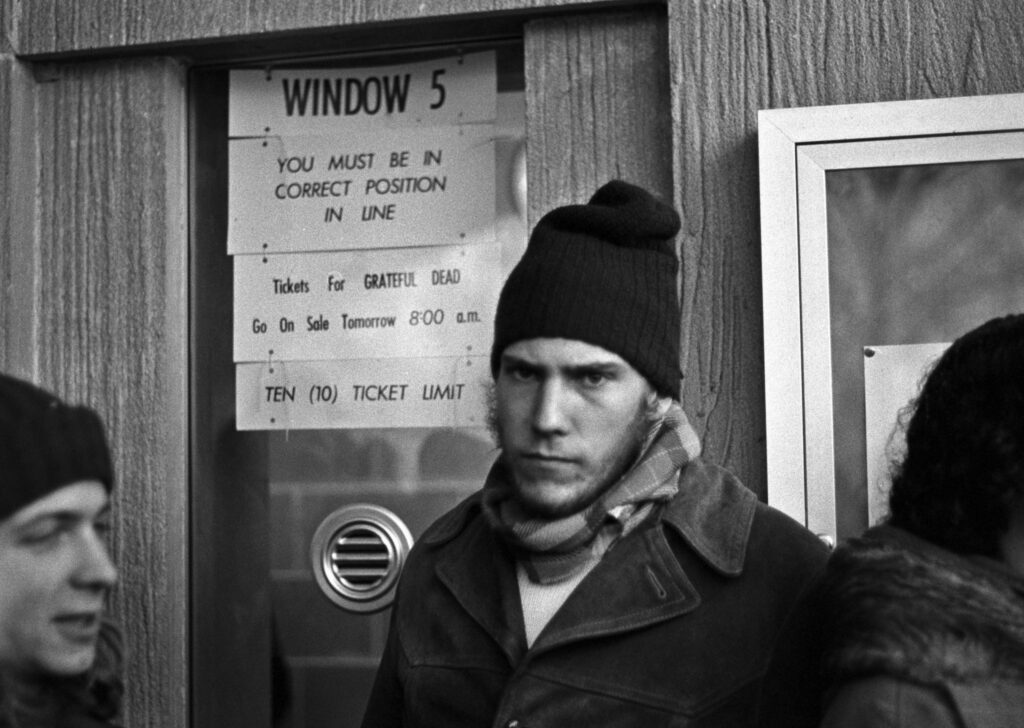The Grateful Dead’s lead guitarist and principal songwriter, Jerry Garcia, once insisted that his band catered to a selective palate: “We’re like licorice. Not everybody likes licorice, but the people who like licorice really like licorice.” Ray Robertson must really like licorice. This past spring, he contributed liner notes to a pair of the band’s archival releases, and his recent novel, Estates Large and Small, starred a Deadhead protagonist. With his latest work of non-fiction, All the Years Combine, Robertson hand-picks fifty essential shows from the group that performed over 2,300 times between 1965 and 1995 without repeating a set list. He explores the concerts’ historical contexts and sonic characteristics while also fitting them into the narrative arc of the band’s career. This meticulously researched passion project ably explains why the Grateful Dead were such a successful touring act and how they became a cultural touchstone.
The Dead were known for their improvisatory approach to performance and their unconventional relationship with the audience. Unlike their contemporaries — and to the dismay of their various record labels — they seemed to view studio albums as mere contractual obligations. They were more invested in the relentless touring that allowed for their live musical explorations. While the band recorded most of their shows themselves, they also encouraged bootlegging, even cordoning off prime locations for “tapers.” (“When we’re done with it, they can have it,” Garcia quipped.) Because they always improvised, each performance was guaranteed to be unique, and these recordings became fodder for widespread trading. Certain rare or revered concerts acted as status symbols for Heads everywhere. Indeed, there wasn’t much the Dead couldn’t (or wouldn’t) play. Eclectic covers like the traditional New Orleans staple “Iko Iko” also got stage time. With such an extensive vault, even less fanatical fans have been able to enjoy the Dead’s alchemic blend of rock ‘n’ roll, jazz, folk, blues, country, gospel, and reggae through official archive releases.
All the Years Combine includes many high-water marks of the Grateful Dead’s career. April 14, 1972: Tivoli Concert Hall, Copenhagen, the first TV broadcast of a rock concert in Denmark (the band wore clown masks for the occasion). August 27, 1972: Old Renaissance Faire Grounds, Veneta, a benefit on what was then the hottest day in Oregon’s history to raise funds for the historic Springfield Creamery. June 10, 1973: RFK Stadium, Washington, a five-hour marathon that saw members of the Allman Brothers join Jerry and the boys onstage. September 16, 1978: Gizah Sound and Light Theater, Cairo, playing alongside the Sphinx during a lunar eclipse. Of course, Robertson includes the Dead’s legendary performance at Cornell University’s Barton Hall, on May 8, 1977. It’s considered by many Heads to be among the band’s finest, thanks to the warm, crisp mix by the engineer Betty Cantor-Jackson. (In 2011, the Library of Congress inducted the performance into the National Recording Registry, for reflecting “the diversity and creativity of the American experience.”)
Many of the book’s entries fall between 1970 and 1974, when the Grateful Dead were finely tuned and nimble, probing free-form jazzy soundscapes alongside more tightly composed material from their acclaimed LPs American Beauty and Workingman’s Dead (and playing with one drummer instead of their usual two). Robertson does cover the Primal Dead era — the band’s late-’60s period, so named because of their raw, headlong approach to searing blues standards and screeching, feedback-laden exploration — but just five performances across the ’80s and ’90s make the cut. During these decades, the Dead mutated into a “lumbering, MIDI-manacled monolith,” dogged by Garcia’s prolonged struggle with obesity and substance abuse. Still, as Robertson makes clear, there were highlights. Consider the roar of the crowd in Oakland, California, when the band opened their show on December 15, 1986 — their first since Garcia’s nearly fatal diabetic coma some six months earlier — with “Touch of Grey,” their only tune to crack the Billboard Top Ten: “I will get by / I will survive.” No less affecting was the guitarist’s final performance, on July 9, 1995, at Chicago’s Soldier Field. “So many roads I know,” he sang. “All I want is one to take me home.” A month later, he died from a heart attack at fifty-three.

Fans line up days before the Grateful Dead’s February 2, 1979, concert in Carbondale, Illinois.
Brian Crawford; Flickr
Like any Dead show, Robertson’s book is not perfect. He compares Garcia’s scintillating guitar lines to a Monet painting — twice. He lifts a line verbatim —“In the house of the Dead there are many mansions”— from his own recent novel. But such faux pas, which also include flubbed lyrics and misspelled names, are actually par for the course, given that the Dead routinely forgot the words to their own songs. All told, Robertson has written an ideal companion for the devoted Deadhead while charting intimidating territory for the curious. (He even traces the evolution of “Dark Star” from a three-minute studio track in 1968 to a towering forty-three-minute live jam vehicle in 1972.) Considering that Dead & Company, the band’s latest offshoot, led by the veteran members Bob Weir and Mickey Hart, just wrapped up their final tour — grossing $115 million and selling over 840,000 tickets — the Grateful Dead’s enduring relevance can’t be overstated. The music never stops, and books like this one help enshrine it with the reverence it deserves.
Michael Strizic is a devoted Deadhead and former managing editor of the magazine.
Related Letters and Responses
Poppy Miers Conn, Ontario

